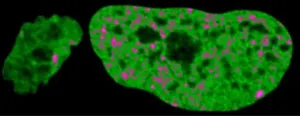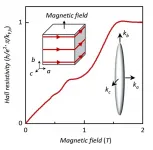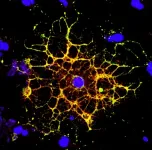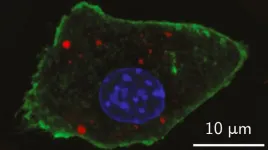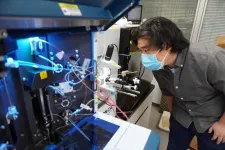(Press-News.org) The organization of the human genome relies on physics of different states of matter - such as liquid and solid - a team of scientists has discovered. The findings, which reveal how the physical nature of the genome changes as cells transform to serve specific functions, point to new ways to potentially better understand disease and to create improved therapies for cancer and genetic disorders.
The genome is the library of genetic information essential for life. Each cell contains the entire library, yet it uses only part of this information. Special types of cells, such as a white blood cell or a neuron, have only certain "books" open - those containing information relevant for their function. Researchers have long sought to determine how the genome manages these enormous libraries and allows access to the "books" that are needed, while storing away the ones not in use.
In the newly published study, which appears in the journal Physical Review Letters, the researchers revealed how this happens within a cell.
"We found that the parts of the genome that are being used are liquid, while the unused parts form solid-like islands," explains Alexandra Zidovska, an assistant professor in New York University's Department of Physics and the senior author of the study. "These solid-like islands serve as library bookshelves storing the books with genes not currently in use, while the liquid genome part acts like an 'open book,' which is readily accessible and used for a cell's life and function."
The genome's genetic information is encoded in the DNA molecule. Proper reading and processing of this information is critical for human health and aging. In a human cell, the genome, which contains the genetic code, is housed in the cell nucleus. Barely 10 micrometers in size - or about 10 times smaller than the width of a strand of human hair - it stores about two meters of DNA.
Storing this vast amount of genetic information in such a small space requires packing in such a way so that each piece of DNA, and thus of genetic code, is easily accessible when needed.
What had been less understood is how this information was stored and what was the role of physics in it.
To explore this phenomenon, the researchers, who also included Iraj Eshghi and Jonah Eaton, NYU doctoral candidates, compared cells before and after they become specialized.
Specifically, the scientists mapped motions of the genome in nuclei of mouse stem cells - those that do not yet have a specialized function, but are poised to become any cell type, such as a neuron or a white blood cell - and then let these cells undergo a differentiation into neuronal cells before mapping the genomic motions again. In doing so, they generated the first-ever maps of a genome's motions before and after cell differentiation.
Here they found that stem cells keep their genome "open" - making it as accessible as an open book, with "genetic pages" being easily reachable.
However, the mapping also showed that once a stem cell becomes a specialized cell, e.g. a neuron, this specialized cell keeps readily accessible only parts of the genome that are needed for its specific function. It puts away the unused parts of the genome on "bookshelves." This leaves more space for information that is being actively read out and processed.
"These motions tell us exactly how accessible the genome is in a given place in the cell nucleus," explains Zidovska. "Moreover, these motions reveal the physical state of different parts of the genome, with liquid parts corresponding to loosely packed DNA, and solid-like parts corresponding to tightly packed DNA gels. The genome packing in these different states of matter directly impacts the genome's accessibility; the liquid parts are accessible, in contrast to the solid-like parts. The amazing thing is that this organization relies on physics of different states of matter, liquid and solid."
"Measuring motions of distinct parts of the genome allowed us to show these different physical properties of different parts of the genome, and thus understand the genome organization--the cell's 'library system,' " she adds.
A proper cellular filing system is vital for human health, the researchers note.
"Considering the vast number of cell types in the human body, if a book is missing or misplaced in this cellular library, it may lead to missing or unnecessary information, possibly leading to developmental and inherited disorders as well as afflictions such as cancer," explains Zidovska. "Therefore, revealing how the genome is organized inside the cell nucleus is critical to our understanding of these conditions and diseases. Moreover, such knowledge may help us in designing future therapies and diagnostics of such disorders."
INFORMATION:
The research was supported by grants from National Science Foundation (CAREER PHY-1554880, CMMI-1762506 and NYU MRSEC DMR-1420073), National Institutes of Health (R00-GM104152), and a New York University Whitehead Fellowship for Junior Faculty in Biomedical and Biological Sciences.
DOI: 10.1103/PhysRevLett.126.228101
SMU Office of Research & Tech Transfer - Short selling often gets a bad rap because it is a type of trade that bets against the success of a firm. In essence, short selling allows investors to borrow stock from a broker to sell into the market with the hope of buying the stock back at a cheaper price, thus, profiting on the difference between the sell and buy prices. Because of this practice, short selling is sometimes seen as a controversial tactic.
Furthermore, speculative short selling attacks are concerning as it can put downward pressure on ...
The quantum Hall effect traditionally only plays a role in two-dimensional electron systems. Recently, however, a three-dimensional version of the quantum Hall effect was described in the Dirac semimetal ZrTe5. It has been suggested that this version results from a magnetic field-induced Fermi surface instability that transforms the original three-dimensional electron system into a stack of two-dimensional electron systems. Now scientists at the Max Planck Institute for Chemical Physics of Solids in Dresden, at the Technical University of Dresden, at the Brookhaven National Laboratory in New York, at the Helmholtz Center Dresden-Rossendorf, the Max Planck Institute ...
Boulder, Colo., USA: GSA's dynamic online journal, Geosphere, posts articles online regularly. Locations and topics studied this month include the Moine thrust zone in northwestern Scotland; the Eastern California shear zone; implementation of "OpenTopography"; the finite evolution of "mole tracks"; the southern central Andes; the work of International Ocean Discovery Program (IODP) Expedition 351; and the Fairweather fault, Alaska, USA. You can find these articles at https://geosphere.geoscienceworld.org/content/early/recent.
Detrital-zircon analyses, provenance, and ...
RIVERSIDE, Calif. -- As its name suggests, dark matter -- material which makes up about 85% of the mass in the universe -- emits no light, eluding easy detection. Its properties, too, remain fairly obscure.
Now, a theoretical particle physicist at the University of California, Riverside, and colleagues have published a research paper in the Journal of High Energy Physics that shows how theories positing the existence a new type of force could help explain dark matter's properties.
"We live in an ocean of dark matter, yet we know very little about what it could be," said Flip Tanedo, an assistant professor of physics and astronomy and the paper's senior author. "It is one of the most vexing known unknowns in nature. ...
It's long been known that people living with HIV experience a loss of white matter in their brains. As opposed to "gray matter," which is composed of the cell bodies of neurons, white matter is made up of a fatty substance called myelin that coats neurons, offering protection and helping them transmit signals quickly and efficiently. A reduction in white matter is associated with motor and cognitive impairment.
Earlier work by a team from the University of Pennsylvania and Children's Hospital of Philadelphia (CHOP) found that antiretroviral therapy (ART)--the lifesaving suite ...
There is a long-held belief that having your pet sleep on the bed is a bad idea. Aside from taking up space, noisy scratching, or triggering allergies, the most common assertion averred that your furry companion would disrupt your sleep.
A new study published in the journal Sleep Health tells a different story. Researchers at Concordia's Pediatric Public Health Psychology Lab (PPHP) found that the sleep quality of the surprisingly high number of children who share a bed with their pets is indistinguishable from those who sleep alone.
"Sleeping with your pet does not appear to be disruptive," ...
Do firms respond to tougher competition by searching for completely new technological solutions (exploration), or do they work to defend their position by improving current technologies (exploitation)?
Competition from increased import penetration generally results in tight profit margins, low prices, and strong efficiency pressures, immediately affecting firms' bottom lines in the form of reduced profits and increased bankruptcy risk.
A firm's R&D strategy is one of the fundamental determinants of success or failure when responding to competitive threats. To ensure both short-term performance and long-term survival, firms have two basic R&D options: explore new knowledge or exploit existing knowledge bases. ...
A new study by a team of University of Rochester psychologists and other researchers in the Collaborative Initiative on Fetal Alcohol Spectrum Disorders (CIFASD) finds that partners of mothers-to-be can directly influence a pregnant woman's likelihood of drinking alcohol and feeling depressed, which affects their babies' development.
The study, which appeared in Alcoholism: Clinical & Experimental Research, highlights the importance of engaging partners in intervention and prevention efforts to help pregnant women avoid drinking alcohol. A baby's prenatal alcohol ...
Nano-sized particles have been engineered in a new way to improve detection of tumors within the body and in biopsy tissue, a research team in Sweden reports. The advance could enable identifying early stage tumors with lower doses of radiation.
In order to enhance visual contrast of living tissues, state-of-the-art imaging relies on agents such as fluorescent dyes and biomolecules. Advances in nanoparticle research have expanded the array of promising contrast agents for more targeted diagnostics, and now a research team from KTH Royal Institute of Technology has raised the bar further yet. They are combining optical and X-ray fluorescence contrast agents into a single enhancer for both modes.
Muhammet ...
Researchers from Sinai Health have published a study providing an ultra-detailed look at the organization of a living human cell, providing a new tool that can help scientists around the world better understand what happens during disease.
The new study, out today in the journal END ...
